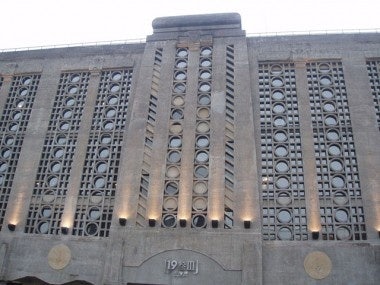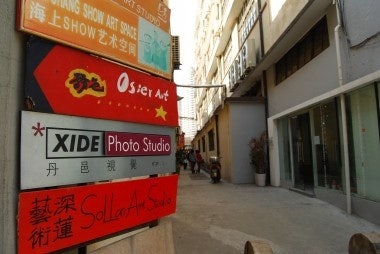Is Beijing, As Arts Capital Of China, Shooting Itself In The Foot By Destroying Cultural Hotbeds?#

Since the earliest stirrings of the Chinese contemporary art movement in the late 1970s, Beijing has been China's undisputed arts epicenter, with many of the country's best and most renowned artists beginning their careers in the city's early arts districts such as the East Village and Yuanmingyuan, and later settling in arts "colonies" like 798 and Caochangdi.
Over the course of the 1990s, when Beijing's large-scale demolition/construction boom began to pick up steam, early arts districts like the East Village and Yuanmingyuan met the wrecking ball, but as Chinese contemporary art began to attract the attention of collectors and galleries around the world newer districts like 798/Dashanzi and, later, Caochangdi, Songzhuang, Suojiacun and Dongying -- which have become tourist attractions as well as cultural hotbeds in their own right over the past 20 years -- appeared to dodge bullet after bullet while much of Old Beijing came tumbling down in the run-up to the 2008 Olympics.
However, over the past few months it has become clear that a thriving arts scene, one thing that Beijing's cultural community has always prided itself on over rivals like Shanghai, may not be enough to save Caochangdi from the wrecking ball. Since last August, arts district after arts district has found itself in the crosshairs, with Dongying, Zhengyang Creative, 008, Xiedaoxi, Beigao and Suojiacun quickly being wiped from the map -- displacing more than 1,000 artists, according to China Daily.
However, in many ways Caochangdi stands apart from smaller and less well-known (yet not less important) areas like Dongying or Suojiacun.With world-class arts venues like the Three Shadows Photography Art Centre, the Urs Meile Gallery and the Pékin Fine Arts Gallery, and studios and warehouses (and, in some cases, houses) built by world-famous artists such as Ai Weiwei and Rong Rong, Caochangdi is considered one of Beijing's most important contemporary cultural hotbeds. This recognition notwithstanding, last month the Chaoyang district government announced plans to "redevelop" the area, issuing eviction notices to all enterprises in the area. According to the Global Times, in response to these demolition plans, artists, galleries and supporters have united to petition the city government for the area's preservation.
From the Global Times:
On April 16, one day before the second annual launch of Beijing's biggest photography festival—the Caochangdi PhotoSpring—village authorities notified all resident enterprises that the area was set for evictions and demolition, but no specific time was mentioned.
"The notification came a few hours before official approval of the photography festival," Rong Rong, director of the TSPAC, told the Global Times. "It was a bitter-sweet and confusing day for me."
A petition quickly started circulating among festival goers that called for the eviction and demolition plan to be reevaluated. According to Stephanie Tung, who works at the TSPAC, more than 500 have signed the petition so far, including representatives from the French and German Embassies.
Zhang Gengqu, Caochangdi party secretary, told the Global Times the informational survey the local government is currently undertaking would help the district be better understood for a proper solution to be found. "Caochangdi is our landmark," said Zhang. "We will try our best to preserve it, but it depends on the city planning committee. So far, nobody knows."
A press conference held by a Chaoyang district commissioner last July announced that the land comprising seven townships, including Cuigezhuang (where Caochangdi is located), would be reserved as part of an unknown "Urbanization Land Reserve Motivation" (ULRM) initiative, with all eviction, relocation and demolition work scheduled to be completed by June of this year.
Clearly, the hundreds of artists and galleries working and operating in Caochangdi won't go down without a fight, and with the clout (and international renown) of artists like Ai Weiwei, Huang Rui, Rong Rong and others in the area, there's hope that Caochangdi might have the same luck as 798 -- which was only saved from demolition by intense lobbying in 2008. Ultimately, 798 received recognition from the Beijing city government as an arts and tourism destination, saving it -- hopefully forever -- from being overtaken by Beijing's breakneck development. If Beijing doesn't extend the same recognition to Caochangdi, what hope or reason would Beijing's artists -- many of whom have had to relocate time after time -- have to stay in the city or move to a newer district like Songzhuang?

Without a show of good faith by the Beijing city government, it's likely that a good proportion of these artists would look elsewhere. And for many, that "elsewhere" just may be Shanghai. While Beijing seems intent on demolishing its arts districts and imperiling its position as the heart of contemporary Chinese culture, Shanghai -- the country's economic capital -- is dead set on building its arts infrastructure, understanding that a true "world city" needs more than just a strong business sector.
Last week, in a China Daily editorial, Chen Weihua noted that Shanghai -- despite its breakneck development and hosting of the 2010 World Expo -- will never be a world-class city unless it develops into a cultural, as well as an economic, center. According to Chen, all the skyscrapers in the world mean nothing unless people around the world are drawn to Shanghai for more than the pursuit of a quick buck. From Chen's piece:
Shanghai needs a clear vision in preserving its history and developing cultural scenes. Doing so may not generate as much profits as a financial, shipping or trade hub, but it will surely make the city and life in the city much better.

Apparently, plenty of people in Shanghai are well aware of the city's relative dearth of cultural capital. In recent years, encouraged by city government support for developing Shanghai's cultural infrastructure, galleries near the Old French Concession, the Bund, and People's Square have thrived, along with the Moganshan/M50 (莫干山路50号) art district, where galleries like ShanghART, Vanguard画廊 and Art Scene China have set up shop.
Over the last year in particular, construction or reconstruction of Shanghai's arts infrastructure has kicked into high gear, with creative/lifestyle venues like 1933 (a restored Jazz Age abattoir), the Shanghai Songjiang Creative Studio, and the Rockbund Art Museum hosting exhibitions like Cai Guo-Qiang's "Peasant da Vincis" and the 40-artist "Bourgeoisified Proletariat" show. Additionally, top Chinese contemporary artists like Zhang Huan have set up shop in Shanghai, building vast studios without worry of demolition, and a vibrant youth and street art culture -- reflected in sites like NeoCha -- gives Shanghai an "edge" not unlike that seen in early-90s Beijing.
While some would scoff about Shanghai's plan to become a cultural hub on par with Beijing, if Beijing's rampant growth continues to cannibalize its creative infrastructure and alienate the Chinese creatives -- not just VIPs like Rong Rong and Ai Weiwei, but also young art graduates and creative professionals -- who have contributed to Beijing's reputation as one of the most interesting cities in the world for art lovers, the city is at risk of becoming exactly what Shanghai is trying to avoid becoming: a gleaming, modern cultural desert.